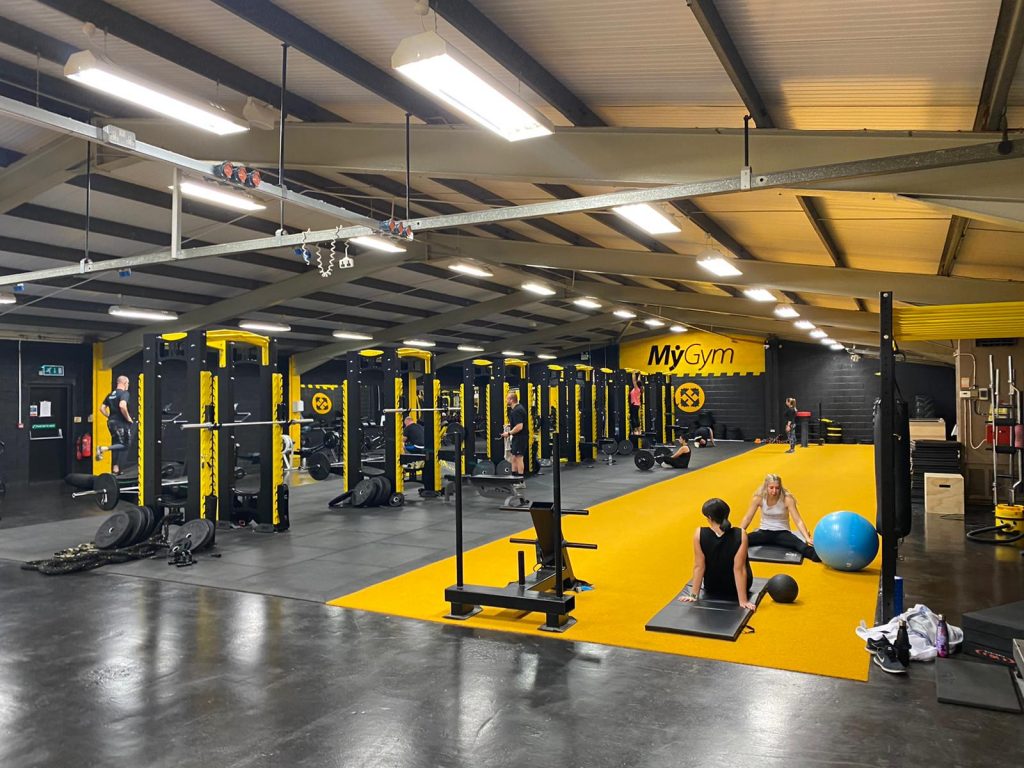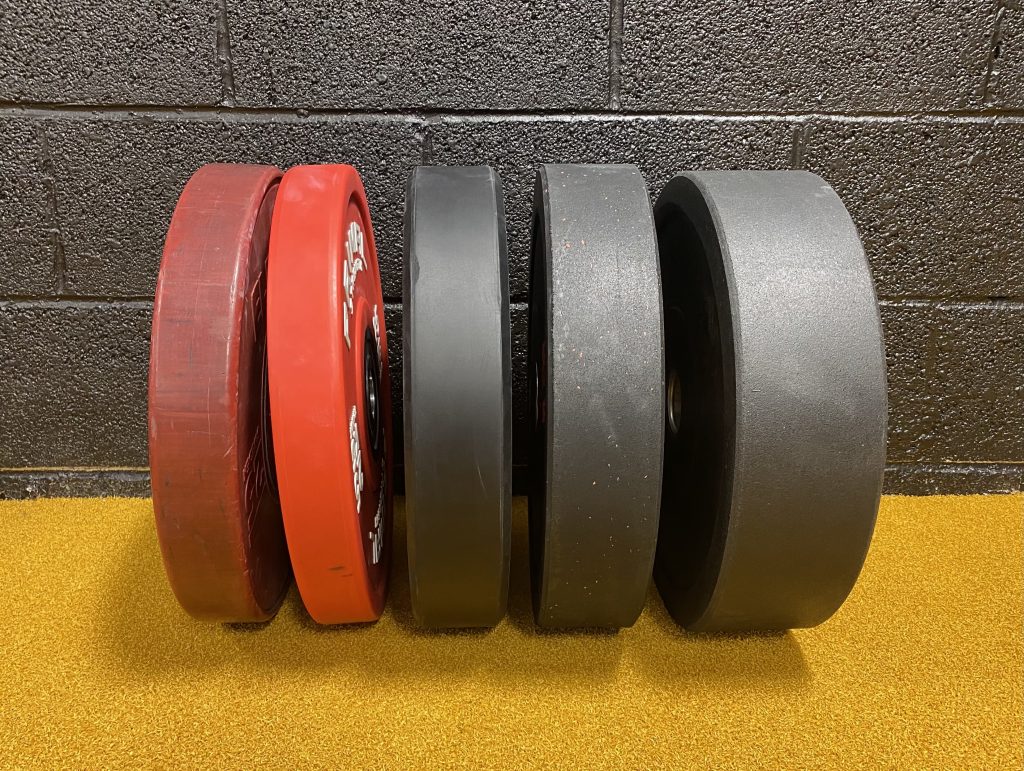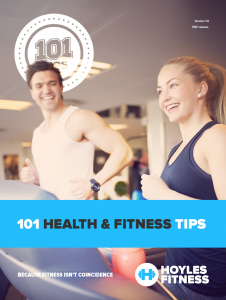What Are Bumper Plates? All the Info You’ll EVER Need…
Bumper plates have exploded in popularity since CrossFit dragged weightlifting into the mainstream. I must have been asked ‘what are bumper plates?’ at least once per week for the last 5 years, so it’s probably about time I wrote the guide to bumper plates!
In this article I’ll discuss the differences in materials, types, cost and use of bumpers. Whilst I won’t make a recommendation of a brand, I’ll inform you about what you should be looking for when it comes to your particular needs, because different plates have different qualities – some you can overlook, others that you can’t.
What are Bumper Plates?
Bumper plates are a type of weight plate made specifically for weightlifting. They’re thicker than other types of plate and are always constructed with rubber around a central metal hub, which allows them to be dropped on the floor without damaging either the floor or the plate.
If you’re looking for equipment for a home (or commercial) gym, you should be looking at bumper plates. When it comes to general fitness training, there’s not really any other game in town.
When you consider that the plates you buy for your gym are going to be one of the most expensive (sometimes the most expensive) items of kit you’ll buy, it’s a decision you want to get right. They’re not cheap to replace and if we’re being honest, plates are as important to a gym as they are to a restaurant, so it’s not a decision you want to get wrong!
If you follow the advice in this guide you really won’t go far wrong, plus it’ll save you an absolute age when it comes to research and understanding the differences between bumper plate sets.
Why should you trust me?
Well I own a gym in Stockport called MyGym. I have bought nearly 3000kg of bumper plates in all different styles, so I know a thing or two about them. I own every different type of bumper plate, so I’ve learned a thing or two about them!

Why Buy Bumper Plates?
There are lots of options for weight plates out there, so why should you look to buy bumpers specifically? Here’s a few of the main reasons for doing so…
Versatility
With bumper plates you can do all of the different types of lifting – you can perform weightlifting, powerlifting and bodybuilding. You can’t do weightlifting with standard cast iron or urethane wrapped plates, nor can you do it with powerlifting plates.
Noise Cancellation
Bumpers are far quieter when they’re dropped on the floor than the other types of plates, because they’re wrapped in rubber. They’re also usually used with rubber matting, which helps to deaden sound and protect the floor at the same time.
Floor Protection
The thicker width of bumper plates coupled with the flat surfaces on the plates helps to protect your floor. By spreading the weight across a larger surface area there’s less pressure through one particular spot when the weights are dropped. The rubber also helps to soften the blow too.
Lifter Safety
Bumpers are designed to be dropped on the floor, so they’re the perfect plate for anyone training on their own without a spotter. If you get tired during a squat or deadlift and you just can’t complete the lift, don’t worry – you can just drop it on the floor! You save your back from blowing out and don’t damage your plates or floor – winner!
Bumper Plates – The Different Types
Just to confuse matters, there are different types of bumper plates. There are ‘competition bumper plates’ and there are ‘training bumper plates’.
Competition Bumper Plates
Competition bumper plates are the most expensive. They’re typically made from a vulcanised virgin rubber wrapped around a central steel insert. The steel insert is heavier than the rubber, so less rubber has to be used. This makes the competition bumper plates thinner, meaning you can fit more on the bar (if you’re really strong!)
Competition plates are colour coded in line with the IWF (International Weightlifting Federation) guidelines. The colours are standardised in the following weight denominations…
- 25kg and 2.5kg – Red
- 20kg and 2kg – Blue
- 15kg and 1.5kg – Yellow
- 10kg and 1kg – Green
- 5kg and 0.5kg – White/Grey
These colours are standardised and serve as an easy way for referees and spectators to see what weight is on the bar when the numbers are hidden by other plates.
If plates aren’t coloured, they’re not sanctioned for use in competition.
Training Bumper Plates
Training (also known as ‘standard’) bumper plates are cheaper because of a different construction method. They typically have a small metal insert, thin enough to protect the rubber against the barbell. Thanks to less metal used in their construction, training plates tend to be thicker than competition bumper plates. Also, because rubber is cheaper than metal, they’re cheaper to make therefore cost less to buy.
Training bumper plates are usually plain black, but some brands will colour them either with flecks of coloured rubber, or a stripe on the plate itself that will indicate the weight.
The other difference between the two types of place is how high they bounce. The training bumper plates have more rubber in their construction so tend to bounce higher than the competition bumper plates. You can check how how high plate will bounce by viewing its durometer score, which I’ll go into more detail on later.
Bumper Plate Construction Methods and Materials
As I mentioned in the last section, bumper plates are constructed with rubber wrapped around a central steel hub. There are a couple of types of rubber used…
Virgin Rubber
This is rubber that hasn’t been used before. It is often vulcanised, which essentially means is hardened. This is useful for the longevity of the plates as they will be dropped thousands of times in their lifetime, so vulcanised rubber lasts a lot longer. It’s a thinner, smoother finish than the crumbed rubber.
Crumbed Rubber
Cheaper bumper plates are made with a crumbed rubber – this is recycled rubber that has been previously been used for other purposes. The rubber tends to be compressed and bound together with adhesive, making for a much thicker bumper plate. Whilst they’re generally OK, they are budget bumper plates and won’t last as long as the virgin rubber.
Bumper Plate Thickness
As a general rule of thumb, the more expensive the plate, the thinner it is. This is certainly true when it comes to crumbed rubber versus virgin rubber, but the virgin rubber can be made heavier in different ways so the thinner plates aren’t always the most expensive. Here’s an example…

The plates in this list are ordered from left to right in terms of cost. They’re all a 25kg bumper plate, but you can see the differences in thickness. Of the two competition (coloured) bumpers, the $475/£350 Eleiko Plate (dark red, far left) is slightly thicker than the Primal Strength plate (bright red), but it’s twice the price.
The middle plate is a virgin rubber training plate, the next on the right is a crumbed rubber with red rubber flecks in and the plate on the right is the cheapest, thickest crumbed rubber plate. This picture highlights the variety in bumper plate thickness despite the same weight throughout.
Qualities of Different Types of Bumper Plates
Competition Bumper Plates
Competition Bumper Plates thinner plate with a central steel insert that spins around a bar faster during a lift – this makes for a smoother, more controlled lift. It’ll also bounce lower when dropped, which is something to consider when you’re short on space. The colour also allows you to gauge the correct weight quickly.
Vulcanised Rubber Training Bumper Plates
The vulcanised rubber bumper plates share the robust nature of the competition plates – they’ll take a lot of use so will give you plenty of value. They bounce higher than the competition plates, but they’re nice to lift and don’t take up too much room on the bar or in storage.
Crumbed Rubber Bumper Plates
With them being the cheapest, they also contain the most rubber. This makes them a much bigger, thicker plate that bounce quite high when dropped. If you don’t have much space, the bouncing and the storage of crumbed rubber bumper plates can be a problem. They’re also more susceptible to damage, but this should take some time before it becomes an issue. Being thicker, you can’t fit as many plates on a bar.
Buying Advice for Bumper Plates
The type of bumper plates you’ll buy will in part be determined by what you’re going to use them for.
Competition Bumper Plates
If you’re a competitive weightlifter the reality is you’ll be better off buying competition bumper plates – they’ll cost you more, but you’re always better training with the equipment you’re going to compete with, because you’ll be used to how they move and spin on a bar. Thinner plates also ‘feel’ different. The fact that they’re smaller means you can fit more on a bar, so if you’re super strong you may need them!
Finally, if you’ve got the money and want the best, go for competition plates. They look cool, they’re hard wearing and you’ll be using them for years. They’re easier to store because they’re smaller.
Best for: Competitive lifters. Super strong people. Those with bigger budgets.
Virgin Rubber Training Bumper Plates
If you’re using your bumper plates for general training, say a mixture of weightlifting and bodybuilding, I’d suggest you go with a standard black, virgin rubber training bumper plate set. You’ll combine the quality and robustness of a hard wearing rubber with a similar width to the competition plates. They’re suitable for all types of lifting and will last you a long time.
You don’t need the expense of the coloured competition plates unless you’re competing, so you can save the money and still benefit from most of the qualities of the competition plates. They’ll withstand the high-rep weightlifting nature of CrossFit on most floors.
Best for: Non-competitive CrossFit, Weightlifting and Bodybuilding.
Crumbed Rubber Bumper Plates
Crumbed rubber plates are the budget choice. If you’re using them for bodybuilding and basic weightlifting, they’ll be OK. They’re only really suitable for floors that have rubber mats on though, otherwise they’ll start to break down quicker than the other types. If you’re doing high-rep weightlifting such as CrossFit, I’d urge you to spend a little more money and buy the virgin rubber plates – they’ll last a lot longer.
If you simply can’t stretch that far, or don’t want to, you’ll still benefit from a great set of plates with crumbed rubber as long as you don’t use them on anything but flat, smooth floors. They’re the thickest bumpers though, so you won’t be able to load as much weight on the bar and you’ll need more storage room!
Best for: Lifters on a budget, bodybuilders and weightlifters not doing high-rep work. Those with a lot of storage space.
Bumper Plates Buying Considerations
Before you pull the trigger on a buying decision, here’s a few additional points to consider…
Buy in Sets
You almost always save money when you buy your plates in sets. As with anything in life, you buy in bulk, you save money. That’s certainly the case with bumper plates. You can save a fortune if you buy a set rather than individuals.
It also gives you more scope for strength growth. If you have extra plates you’ll be less likely to outgrow your set up. Most sets start at around 150kg, so shoot for around 250 and you’ll pretty much be set for life!
Durometer Score
This refers to the hardness of the rubber. The higher the score, the harder the rubber and the less bounce there is in the plate. Generally speaking higher quality plates have a higher durometer score. If you want a low bounce plate, you should be looking at an 85 and above durometer score.
Plates with a higher durometer score are more expensive, but they’re also much tougher and are likely to last a lot longer so may well be worth the extra cost. There are Eleiko plates that have been used for decades that are still going strong to this day!
Bumper Plates Info, Concluded
Where bumper plates were once the reserve of the weightlifting club, their versatility and performance benefits mean that they’re the ideal choice for almost all gyms. Use this guide to narrow down what you’re looking for and you won’t go wrong!
